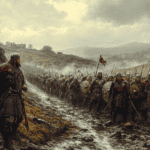
In the tumultuous landscape of 11th-century Wales, one figure stands out as a beacon of unity and power: Gruffudd ap Llywelyn. Born around 1010, Gruffudd would rise to become the first and only ruler to unite all of Wales under a single crown, earning him a unique place in Welsh history.
Gruffudd’s path to kingship was paved with conflict and strategic alliances. He was the son of Llywelyn ap Seisyll, who had ruled both Gwynedd and Powys, and Angharad, daughter of Maredudd ab Owain of Deheubarth. This royal lineage provided Gruffudd with a claim to power, but it was his military prowess and political acumen that would secure his position.
In 1039, Gruffudd emerged as the king of North Wales, marking the beginning of his ambitious campaign to expand his realm. His early years as ruler were marked by bloody conflicts as he sought to consolidate his power and extend his influence across Wales.
Conquests and Expansion

Gruffudd’s reign was characterized by relentless expansion and a series of military victories that gradually brought more of Wales under his control. In 1044, Gruffydd ap Llywelyn faced one of his most formidable challenges as Hywel ab Edwin, the deposed king of Deheubarth, returned with a formidable Viking fleet to reclaim his lost kingdom.
Hywel, having been previously expelled by Gruffydd, had spent his exile gathering support in Ireland. He returned with a fleet of twenty Viking ships, their dark sails a menacing sight as they entered the Tywi estuary. The Vikings, likely from Dublin, were battle-hardened warriors eager for plunder and conquest.
Gruffydd, alerted to the invasion, swiftly marshaled his forces to meet the threat. The Welsh king’s army, composed of his loyal household guards and local levies, took up defensive positions along the shore. As Hywel’s fleet approached, Gruffydd’s archers unleashed a barrage of arrows, while his infantry prepared for close combat.
The battle was fierce and bloody. Viking axemen clashed with Welsh spearmen in the shallow waters of the estuary. Gruffydd, leading from the front, fought for hours before Hywel’s army was routed, and the would-be king himself fell in battle. The Vikings, their leader slain, retreated to their ships, leaving Gruffydd victorious.
However, Gruffudd’s conquest of Deheubarth was not complete until 1055 when he killed his rival, Gruffydd ap Rhydderch, in battle. This victory marked a turning point in Gruffudd’s reign, as it brought the southwest of Wales under his control and set the stage for his eventual rule over all of Wales.
Diplomatic Maneuvers and Alliances

Gruffudd’s success was not solely due to his military might. He demonstrated remarkable political skill in forging alliances and exploiting divisions among his enemies. In 1052, he allied himself with Earl Swegn Godwinesson to subdue his rivals in southwest Wales. This alliance showcased Gruffudd’s ability to navigate the complex political landscape of Britain, extending his influence beyond the borders of Wales.
According to the Anglo-Saxon Chronicle, Gruffudd launched an attack across the border into English territory, targeting the prosperous settlement of Leominster. This incursion prompted a swift response from the local Anglo-Saxon forces, who were bolstered by Norman mercenaries.
The ensuing battle, named after the Welsh term for Leominster – Llanllieni, saw Gruffudd’s Welsh warriors face off against the combined strength of Saxon and Norman troops. Despite being outnumbered and fighting on foreign soil, the Welsh forces emerged victorious.
This triumph was a significant achievement for Gruffudd, demonstrating his military prowess and the growing power of Welsh forces in the region. The battle’s outcome likely strengthened Gruffudd’s position and reputation, while also highlighting the vulnerability of English border territories to Welsh incursions.
Perhaps his most significant alliance came in 1055 when he joined forces with Ælfgar, son of Leofric, Earl of Mercia. This partnership proved devastating for the English forces. Together, Gruffudd and Ælfgar marched on Hereford, defeating the Norman-influenced army led by Ralph the Timid, Earl of Hereford. They subsequently sacked the city and destroyed its castle, demonstrating the formidable power of this Welsh-Mercian alliance.
The Height of Power
By 1055, Gruffudd ap Llywelyn had achieved what no Welsh ruler before him had managed: he united almost all of Wales under his rule. His domain stretched from the northern coast to the southern shores, with only the obdurate sub-kingdom of Glamorgan in southeast Wales remaining outside his direct control.
Gruffudd’s reign marked the pinnacle of native Welsh rule. He was not merely a local warlord but a king respected and feared across Britain. His court became a center of patronage for the arts and the church, reflecting the trappings of a truly powerful monarch.
Challenges to English Authority
Gruffudd’s expansionist policies did not stop at the Welsh border. He consistently pursued a policy of aggression and expansion along his eastern frontier with England. His raids into English territory were bold and often successful, demonstrating the vulnerability of England’s border defenses.
In 1055, Gruffudd’s alliance with the Mercian Ælfgar reached its zenith. They gathered a huge army and met near the mouth of the River Wye, marching upriver to crush the defending English forces outside Hereford. This victory forced the hand of the English king, Edward the Confessor, who sent Harold Godwinesson to restore order. The peace negotiations that followed saw Edward recognize Gruffudd’s land conquests along the entire length of the England-Wales border, a significant diplomatic triumph for the Welsh king.
The Last Years and Legacy

In the waning months of 1062, the precarious balance of power that Gruffydd ap Llywelyn had so carefully cultivated began to crumble. The death of his staunch ally, Ælfgar, left the Welsh king exposed to the machinations of his enemies across the border. Harold Godwinson, the ambitious Earl of Wessex, seized upon this vulnerability with characteristic ruthlessness.
With the blessing of Edward the Confessor, Harold launched a strike against Gruffydd’s stronghold at Rhuddlan. The attack came without warning, a testament to the element of surprise that would later serve Harold well on other battlefields. Gruffydd, caught off-guard but not unprepared, narrowly evaded capture. As Harold’s men poured into the royal compound, the Welsh king slipped away to the safety of his ships, though not before witnessing the destruction of much of his fleet.
The following spring saw a coordinated assault on Welsh territory. Harold’s brother, Tostig, led a formidable force into the heartland of North Wales, while Harold himself commanded a naval expedition that probed the southern coastline before swinging north to rendezvous with Tostig’s army. This pincer movement, executed with military precision, forced Gruffydd to retreat into the forbidding peaks of Snowdonia.
It was here, amidst the mist-shrouded valleys and craggy slopes, that Gruffydd ap Llywelyn met his end. The circumstances of his death remain shrouded in mystery and conflicting accounts. Some sources suggest he fell victim to his own men, perhaps betrayed by those who had grown weary of his iron-fisted rule. Others point to Cynan ap Iago, son of a rival Gruffydd had dispatched years earlier, as the hand behind the blade.
What is certain is the grisly aftermath. Gruffydd’s severed head, along with the ornate figurehead of his personal ship, were delivered to Harold Godwinson as trophies of victory. These gruesome relics were then forwarded to King Edward, a stark message that the threat from Wales had been neutralized.
Gruffydd’s death marked the end of a brief but remarkable period of Welsh unity. His realm, forged through cunning diplomacy and brute force, quickly fragmented into its constituent kingdoms. Harold, ever the pragmatist, moved swiftly to install more pliable rulers in Gwynedd and Powys. Bleddyn ap Cynfyn and his brother Rhiwallon, willing to acknowledge English overlordship, were granted dominion over these territories.
The repercussions of Gruffydd’s fall would echo through the coming years. When William of Normandy’s armies crashed upon English shores in 1066, they faced not a united Welsh front, but a patchwork of smaller kingdoms, each with its own interests and allegiances. Gruffydd’s sons would make one last, desperate bid to reclaim their father’s legacy in 1069, clashing with Bleddyn and Rhiwallon at the Battle of Mechain. Their defeat was total – one brother slain in combat, the other succumbing to the harsh elements in the aftermath of battle.
Thus ended the line of the man who had, for a brief moment, united all of Wales under a single crown. Gruffydd ap Llywelyn’s reign, marked by both remarkable achievements and brutal methods, had reshaped the political landscape of 11th-century Britain. In his wake, he left Wales once again divided, its future uncertain in the face of Norman ambitions.
Historical Significance
Gruffudd ap Llywelyn’s reign represents a unique moment in Welsh history. For a brief period, he achieved what many thought impossible: a united, independent Wales strong enough to challenge its powerful neighbors. His rule demonstrated the potential of Welsh unity and the strategic importance of Wales in the broader context of British politics.
A thousand years after his birth, Gruffudd ap Llywelyn deserves to be remembered not just as a successful warlord, but as a nation-builder whose vision of a united Wales continues to resonate through the centuries. His story is a testament to the power of ambition, the importance of strategic thinking, and the enduring impact one leader can have on the course of history.




